Spinach is one of the world’s most popular vegetables. It’s a good source of vitamins and minerals, and it’s also low in calories. Spinach is native to parts of Asia and Europe, but it’s now grown worldwide, including in the United States. With proper care and attention, your Spinach plants will reward you with delicious leaves packed with nutrients. If you want to grow Spinach in the US, there are a few things you need to know.
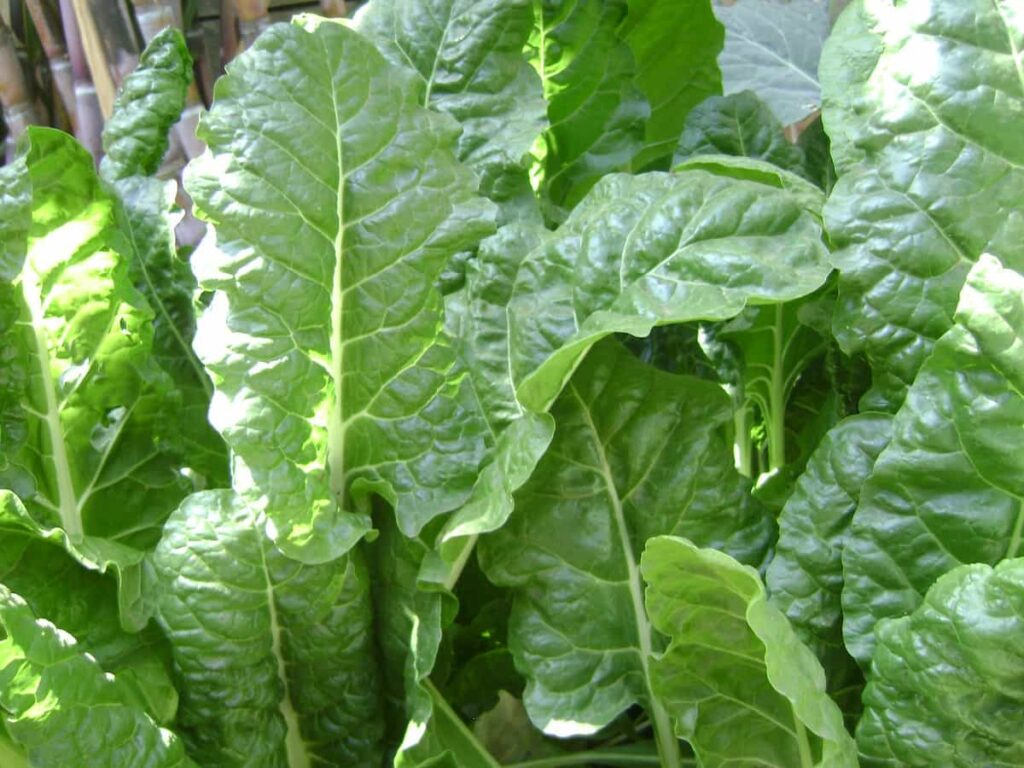
How to grow Spinach in USA
Spinach varieties in the USA
In the United States, three primary types of Spinach are grown commercially. These include:
- Savoy – This type of Spinach has crisp, crinkled leaves that are a deep green. It is best suited for use in salads or as a cooked vegetable.
- Semi-Savoy – This type of Spinach has slightly fewer crinkled leaves than Savoy Spinach but still has a deep green color. It is best suited for cooked dishes or as a fresh baby Spinach leaf in salads.
- Smooth-Leaf – This type of Spinach has smooth, dark green leaves and is the most popular type grown commercially in the United States. It is versatile and can be used fresh in salads, cooked as a vegetable, or frozen for later use.
Spinach propagation methods
Spinach is a cool-weather crop that is best sown in early spring or late summer. Spinach can be propagated by seed or by vegetative methods.
Seed propagation
- To propagate Spinach by seed, sow the seeds in moistened soil about ½ inch deep and 2 inches apart. Keep the soil moist until seed germination occurs, which usually takes 7-10 days. Once the Spinach seedlings have emerged, thin them to 4 to 6 inches apart.
- To grow Spinach from seed, start by purchasing quality seeds from a reputable source. Once you have your seeds, fill a seed tray or pot with moistened potting mix or vermiculite. Sow the seeds thinly in the tray or pot, and cover them with a thin layer of vermiculite or potting mix. Water the seeds gently.
- Place the tray or pot in a warm location from direct sunlight. The seeds should germinate within 10-14 days. Once they have germinated, thin out the seedlings so that the strongest ones remain.
- Transplant the seedlings into individual containers or your garden bed. If you transplant them into your garden bed, space them about 15cm apart. Water them well after transplanting.
- Spinach plants need full sun, partial shade, and well-drained soil high in organic matter. Keep the plants watered during dry periods, and fertilize them every few weeks with a balanced fertilizer such as 10-10-10. Harvest your Spinach when the leaves are big enough to eat.
In case you missed it: Tennessee (TN) Vegetable Planting Calendar: Month-wise Chart, Dates Guide, Schedule for Fall, Winter, Spring, and Summer Seasons
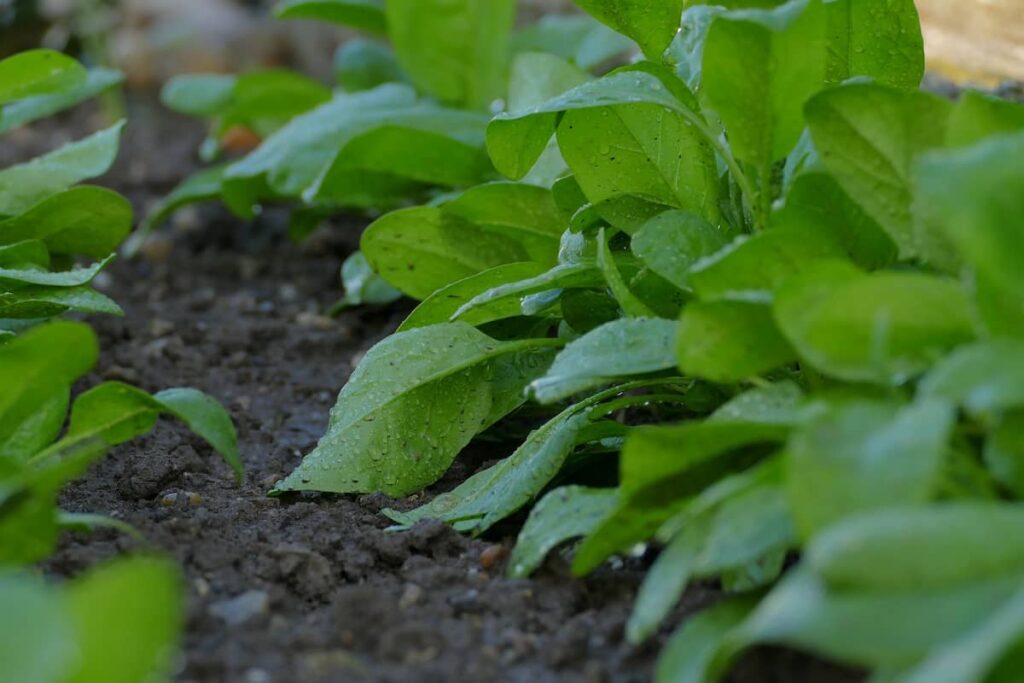
Vegetative propagation
- Spinach can also be propagated by vegetative methods such as rooting stem cuttings or dividing established plants. To take stem cuttings, cut 4–6-inch pieces of the stem from actively growing plants and insert them into a moistened potting mix or sand. Keep the cuttings warm and moist until they develop roots, which usually takes 7-14 days—once rooted, transplant the cuttings into individual pots filled with potting mix.
- To divide established plants, dig up the entire plant and carefully tease it apart into smaller divisions, making sure to include a portion of the root with each division. Replant each division immediately in a prepared bed of rich soil spaced 4-6 inches apart.
Best soil for growing Spinach in the USA
The best soil for Spinach in the USA is loose, well-drained soil with a pH of 6.0 to 7.5. It grows well in full sun but can tolerate some shade. It is a cool season crop that can be planted as early as two weeks before the average last frost date in spring. Spinach can also be planted in late summer.
When growing Spinach in the USA, it is important to keep the soil moist. Water Spinach once or twice a week, depending on rainfall and temperature. In hot weather, Spinach may want to be watered more frequently to prevent the leaves from wilting. Apply a layer of mulch around plants to help retain moisture and control weeds.
Spinach growing areas in the USA
Spinach is mainly grown in temperate climates; it is also possible to find pockets of production in warm weather areas. California and Arizona produce the vast majority of Spinach in the United States. There are also small farms in Florida, Georgia, and South Carolina. The western states of Washington, Oregon, and Idaho also grow this green vegetable. These regions’ cool weather and ample rainfall make them ideal for growing Spinach. Washington State is the second-largest producer of Spinach in the country.
In case you missed it: How to Grow Asparagus in USA: Soil, Propagation, Planting, Care, and Farming Tips
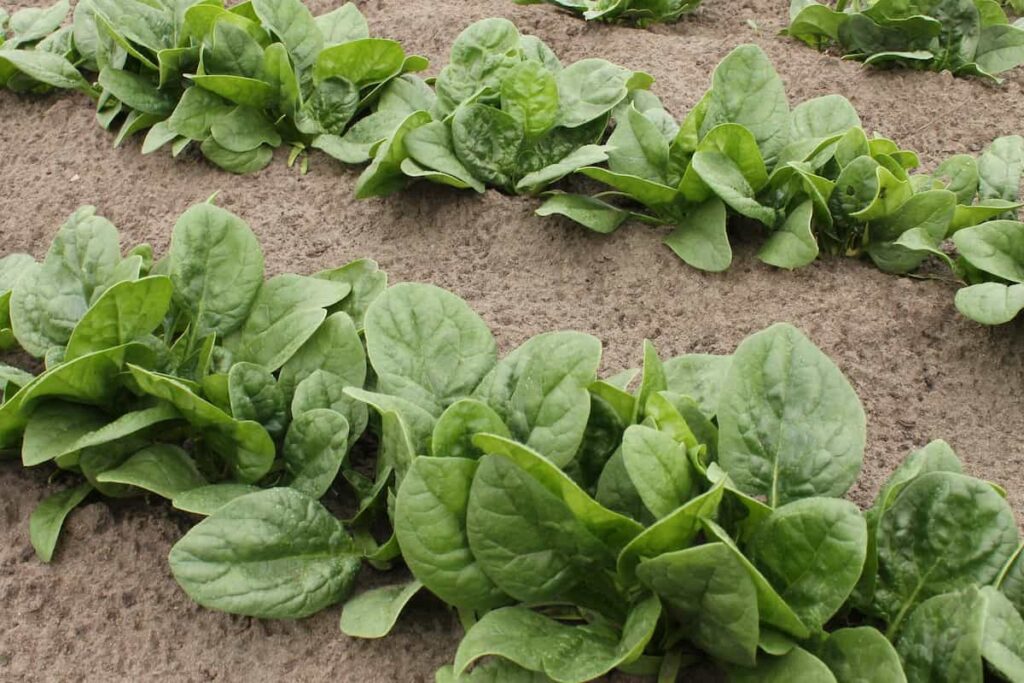
Spinach production and yield in the USA
- The USA is the world’s second-largest Spinach producer, with 3% of world output, following China, which accounts for 85% of output.
- California, Arizona, and New Jersey are the top-producing states, with 12 other states reporting production of 100 acres.
- California accounts for three-fourths of the value of both fresh and processing Spinach crops.
- In the United States, Spinach is produced in all 50 states. The top Spinach-producing states are California, Arizona, and New Mexico. These three states produced over 1 billion pounds of Spinach.
- Spinach is a cool-season crop grown year-round in most regions of the country.
Water and fertilizer requirements for Spinach farming in the USA
Water Spinach plants regularly, especially in hot weather or if growing in containers. Water Spinach regularly during the growing season, especially during dry spells. Fertilize plants every two weeks with a soluble fertilizer such as 10-10-10 or 20-20-20. Apply at half-strength for young plants and at full-strength for mature plants.
Spinach season in the USA
When it comes to Spinach, there are two growing seasons in the United States: spring and fall. The best time for Spinach planting is in the late summer or early fall, about six to eight weeks before the first frost. This way, the plants will have a chance to establish themselves before the colder weather sets in.
Tips for planting Spinach
- Spinach is a cool-weather vegetable that can be grown well in early spring or late summer/early fall. The key to successful Spinach production is to provide consistently moist soil and moderate temperatures. Soil should be well-drained and rich in organic matter.
- Water Spinach plants regularly, especially during dry periods. Mulch around plants to help retain moisture.
- Harvest baby Spinach leaves when they are 3-4 inches long and mature Spinach leaves when they are 6-8 inches long.
- Cut leaves from the plant using scissors or a sharp knife, careful not to damage the plant. Harvesting every other day will prolong the productive life of the plant.
Spinach growing problems and their control
One of the most common problems when growing Spinach is bolting. This occurs when the plant produces a flower stalk to produce seeds. When this happens, the leaves of the plant become tough and bitter. To avoid this, plant your Spinach in an area with full sun and well-drained soil. Another problem that can occur when growing Spinach is leaf spots. This is caused by a fungus that attacks the plant leaves, causing them to turn brown or black.
To prevent this, clean water plants at the base rather than above. Additionally, you can use a fungicide to protect your plants from this disease. Finally, aphids can be a problem when growing Spinach. These small insects suck the sap from the plant’s leaves, causing them to turn yellow and eventually die. To control aphids, you can use an insecticide or release ladybugs into your garden, as they are natural predators of these pests.
In case you missed it: How to Grow Krishna Kamala from Seeds and Cuttings: At Home, In Pots, Steps, Planting, and Care
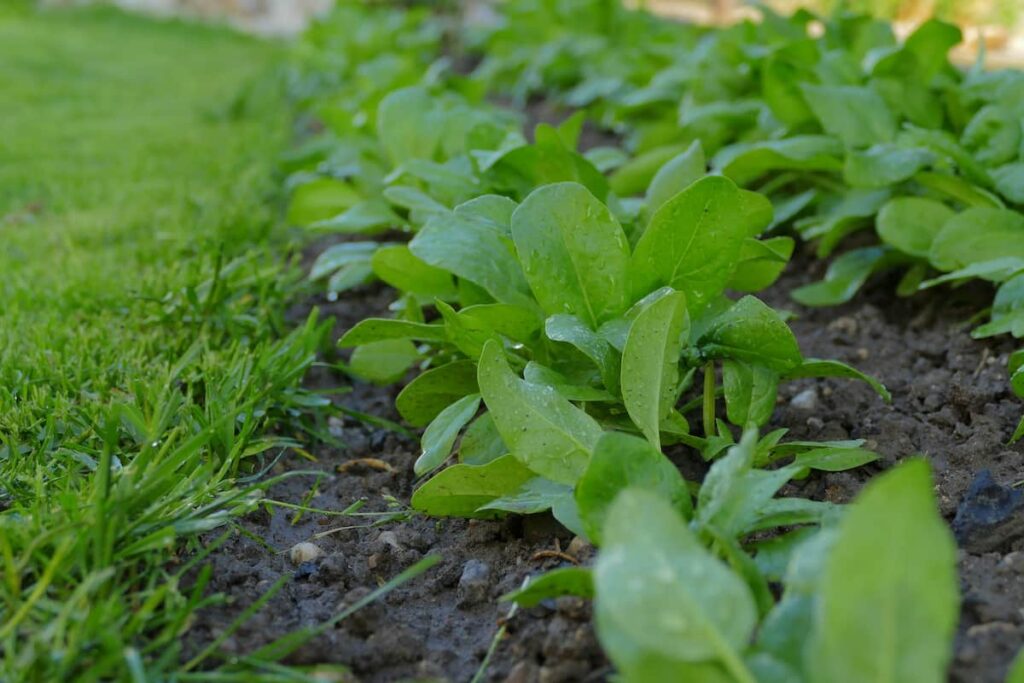
If you notice that the Spinach leaves are changing color, this could be due to several reasons. For example, if the leaves turn yellow, this could be a nutrient deficiency, such as a lack of nitrogen. Alternatively, if the leaves turn red or purple, this could be due to exposure to cold temperatures or too much sunlight. If you’re unsure what is causing the coloring change, it’s best to consult with a gardening expert.
Spinach growing practices in the USA
- Few key things to remember regarding Spinach growing practices in the USA.
- First and foremost, it is important to ensure that the soil is well-drained but moist. This can be accomplished by adding organic matter to the growing soil before planting.
- Secondly, Spinach should be planted in early spring or late fall to avoid the summer heat. If planting in spring, start seeds indoors about four weeks before transplanting outdoors.
- Finally, when it comes to care and farming tips, it is essential to keep weeds under control and water regularly (about 1 inch per week).
Spinach pests and diseases in the USA
Many potential pests and diseases can affect Spinach plants in the USA. These include common problems such as aphids, slugs, leaf spots, and more severe issues like downy mildew and white rust. To prevent or reduce these problems, choosing a healthy Spinach variety for planting is essential, as rotating crops regularly and keeping the plants well-watered. Additionally, using organic pesticides and fungicides can help to control pests and diseases.
Pests
Aphids, caterpillars, and slugs are the common pests that affect Spinach plants. Aphids are small, green insects that suck the sap out of Spinach plants. They can be controlled by spraying them with water or an insecticide. Caterpillars are also affected in Spinach plants and are the larvae of moths and butterflies. They can be controlled by hand-picking them off the plants or using an insecticide. Slugs are slimy creatures that eat leaves and flowers. They can be controlled by setting out traps baited with beer or an organic slug killer.
Diseases
The most common diseases that affect Spinach are downy mildew, powdery mildew, and root rot. Downy mildew is a fungus that causes yellow spots on the leaves. It can be controlled by spraying the plants with a fungicide. Powdery mildew is another fungal disease that causes the white powder to form on the leaves. It can be controlled by spraying the plants with a fungicide or by increasing air circulation around the plants. Root rot problem is caused by too much moisture in the soil and can kill plants. It can be controlled by improving drainage in the soil and by not overwatering the plants
Spinach growing in California
Spinach is a cool-weather plant and grows well in spring and fall. In California, you can sow Spinach seeds outdoors as early as February and as late as October. The key to successful Spinach cultivation is keeping the soil moist during the growing period.
In case you missed it: How to Make Coco Peat at Home: Process, Steps, and Guide
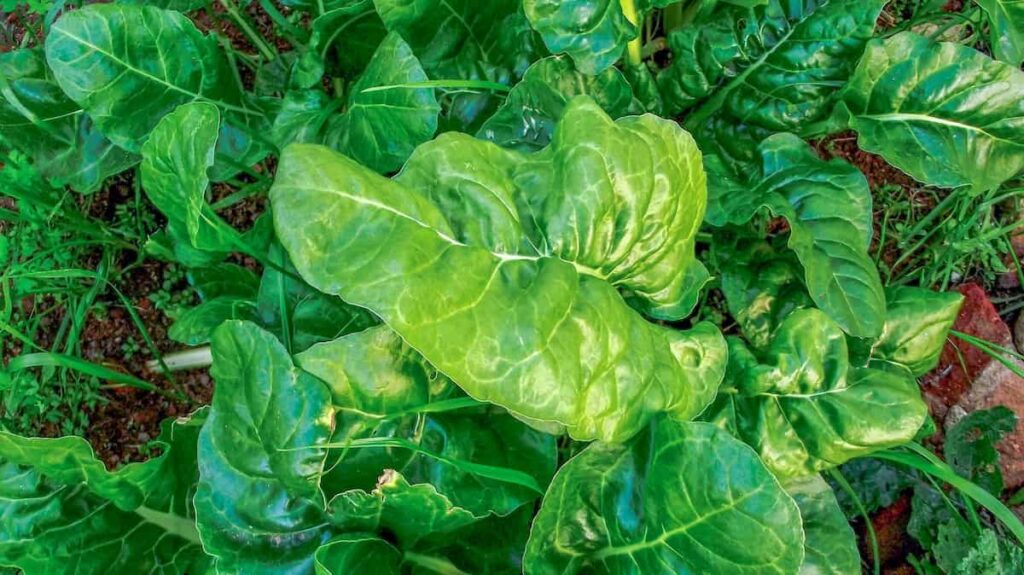
Spinach farming in Arizona
- Spinach is a leafy vegetable, an annual plant that only lasts for one growing season. The plant grows best in cool weather and can tolerate some frost.
- Spinach can be propagated by seed or transplants. For seeds, sow them indoors 4 weeks before the last frost date in the region. Sow the seeds thinly, so they don’t need to be thinned out later. Transplants can be planted outdoors two to three weeks before the last frost date.
- When planting Spinach, space the plants about eight inches apart in rows 18 inches apart. Water the Spinach plants well after planting. Mulch around the Spinach plants to help retain moisture and also control weeds.
Spinach growing in Idaho
Spinach is a cool weather crop planted as soon as the growing soil can be worked in the spring. It is best to directly sow Spinach seed as transplants tend to bolt (go to seed) quickly. Spinach prefers full sun but will tolerate some shade, especially in hot weather. Spinach is a hardy plant that can withstand light frost, making it a good choice for early spring planting in Idaho.
When growing Spinach in Idaho, the most important thing is to keep the plants well-watered, as they will quickly wilt in dry conditions. Spinach does not tolerate heat well, so avoid planting it during the hottest months of the year. Try to succession plant every few weeks to ensure a continuous supply of fresh leaves throughout the season.
Spinach growing in Oregon
Spinach is a leafy green vegetable plant that is popular in many cuisines. It is easy to grow and can be grown in various soils and climates. In the United States, Spinach is most commonly grown in Oregon. The climate in Oregon is well-suited for growing Spinach, with cool winters and mild summers. The soil in Oregon is also rich in nutrients, which helps Spinach plants to thrive.
Few essential things to remember when growing Spinach in Oregon. Firstly, choosing a Spinach variety that is well-suited for the climate is essential. Some varieties of Spinach are more heat tolerant than others, so it is important to select a variety that will do well in the Oregon climate. Second, it is important to water Spinach plants regularly, as they require consistent moisture to produce high yields. Third, it is important to fertilize Spinach plants regularly, as they will benefit from the extra nutrients.
In case you missed it: Vertical Cucumber Farming for the Urban Gardener: Clever Ways to Get More Yields from Small Spaces
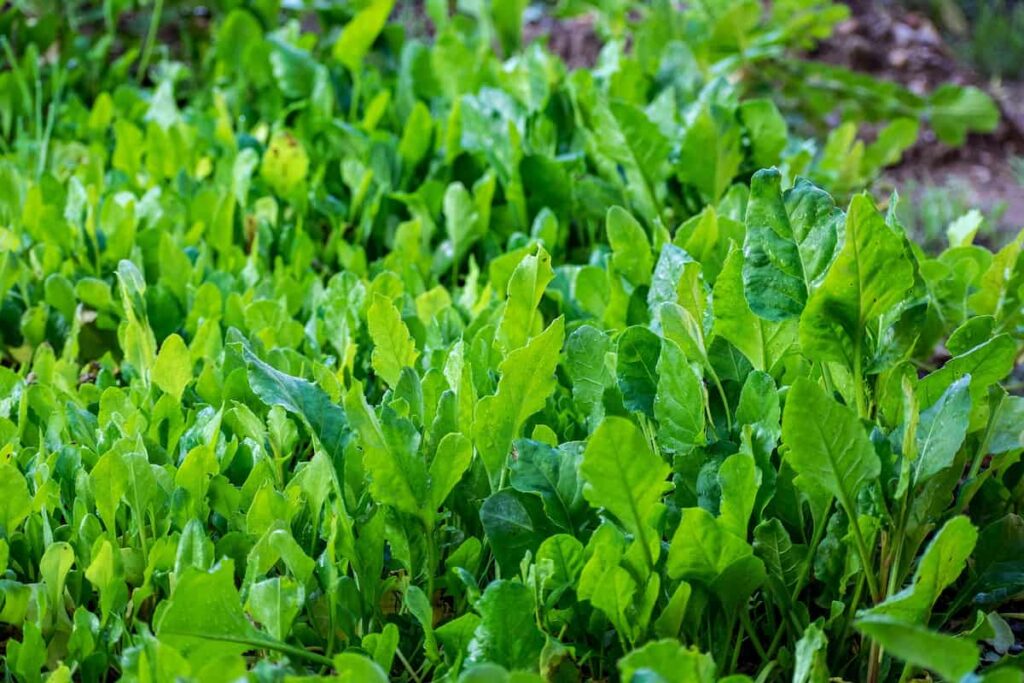
Harvesting and storing your Spinach
Harvesting Spinach is a simple process that can be done by hand or with a small garden tool. The best time to harvest Spinach is in the morning after the dew has evaporated and before the sun gets too hot. To harvest, cut the leaves off at the plant base with a sharp knife or garden shears.
Once you have harvested your Spinach, it is important to store it properly to ensure it stays fresh and does not spoil. The best method to store Spinach is to place it in a container or plastic bag with a few holes punched in it for ventilation and then store it in the refrigerator. Spinach will keep fresh for up to one week when stored this way.
Conclusion
In the United States, Spinach (Spinacia oleracea) is a cool-season vegetable grown throughout much of the country. It is a hardy annual that prefers full sun but will also tolerate some shade. Spinach can be grown in containers, raised beds, or ground. Growing Spinach in the USA can be a great way to have a healthy and bountiful crop.
- Types of Pesticides Used in Agriculture: A Beginner’s Guide
- Economical Aquaculture: A Guide to Low-Budget Fish Farming
- 15 Common Planting Errors That Can Doom Your Fruit Trees
- How to Make Houseplants Bushy: Effective Tips and Ideas
- Innovative Strategies for Boosting Coconut Pollination and Yield
- Pollination Strategies for Maximum Pumpkin Yield
- The Complete Guide to Chicken Fattening: Strategies for Maximum Growth
- Natural Solutions for Tulip Problems: 100% Effective Remedies for Leaf and Bulb-Related Issues
- Revolutionizing Citrus Preservation: Towards a Healthier, Greener Future
- Natural Solutions for Peony Leaf and Flower Problems: 100% Effective Remedies
- Maximizing Profits with Avocado Contract Farming in India: A Comprehensive Guide
- Natural Solutions for Hydrangea Problems: 100% Effective Remedies for Leaf and Flowers
- The Ultimate Guide to Choosing the Perfect Foliage Friend: Bringing Life Indoors
- From Sunlight to Sustainability: 15 Ways to Use Solar Technology in Agriculture
- The Ultimate Guide to Dong Tao Chicken: Exploring from History to Raising
- The Eco-Friendly Makeover: How to Convert Your Unused Swimming Pool into a Fish Pond
- Mastering the Art of Delaware Chicken Farming: Essentials for Healthy Backyard Flocks
- 20 Best Homemade Fertilizers for Money Plant: DIY Recipes and Application Methods
- How to Craft a Comprehensive Free-Range Chicken Farming Business Plan
- Brighten Your Flock: Raising Easter Egger Chickens for Beauty and Bounty
- How to Optimize Your Poultry Egg Farm Business Plan with These Strategies
- Subsidy for Spirulina Cultivation: How Indian Government Schemes Encouraging Spirulina Farmers
- Ultimate Guide to Raising Dominique Chickens: Breeding, Feeding, Egg-Production, and Care
- Mastering the Art of Raising Jersey Giant Chickens: Care, Feeding, and More
- Ultimate Guide to Raising Legbar Chickens: Breeding, Farming Practices, Diet, Egg-Production
- How to Raise Welsummer Chickens: A Comprehensive Guide for Beginners
- How to Protect Indoor Plants in Winter: A Comprehensive Guide
- Ultimate Guide to Grow Bag Gardening: Tips, Tricks, and Planting Ideas for Urban Gardeners
- Guide to Lotus Cultivation: How to Propagate, Plant, Grow, Care, Cost, and Profit
- Agriculture Drone Subsidy Scheme: Government Kisan Subsidy, License, and How to Apply Online
- Ultimate Guide to Raising Araucana Chickens: Breed Profile, Farming Economics, Diet, and Care
- Bringing Hydroponics to Classroom: Importance, Benefits of Learning for School Students
- Ultimate Guide to Raising Polish Chickens: Breed Profile, Farming Economics, Diet, and Care
- Ultimate Guide to Raising Australorp Chickens: Profile, Farming Economics, Egg Production, Diet, and Care
- Silkie Chicken Farming: Raising Practices, Varieties, Egg Production, Diet, and Care
- Sussex Chicken Farming: Raising Practices, Varieties, Egg Production, Diet and Care